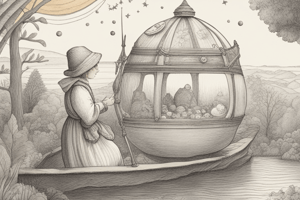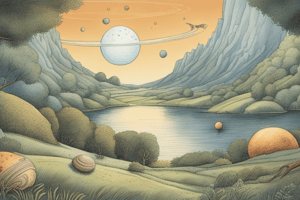Podcast
Questions and Answers
Which planet is the smallest in the solar system?
Which planet is the smallest in the solar system?
Mercury
What is the nickname given to Venus in relation to Earth?
What is the nickname given to Venus in relation to Earth?
Earth's 'evil twin'
What is the main composition of Earth's atmosphere?
What is the main composition of Earth's atmosphere?
Nitrogen and oxygen
What is the temperature range on Mercury's surface?
What is the temperature range on Mercury's surface?
What is the energy source for the Sun?
What is the energy source for the Sun?
Which planet in our solar system is known for having a thick atmosphere?
Which planet in our solar system is known for having a thick atmosphere?
What causes seasonal variations on Earth?
What causes seasonal variations on Earth?
What gives Mars its reddish appearance?
What gives Mars its reddish appearance?
What is the primary composition of Mars' thin atmosphere?
What is the primary composition of Mars' thin atmosphere?
Which planet in our solar system has a storm known as the Great Red Spot?
Which planet in our solar system has a storm known as the Great Red Spot?
What is the most notable feature of Neptune?
What is the most notable feature of Neptune?
Why is Pluto classified as a dwarf planet?
Why is Pluto classified as a dwarf planet?
Flashcards are hidden until you start studying
Study Notes
Overview of Our Solar System
Our solar system is a vast collection of celestial bodies orbiting around a central star - our Sun. It consists of eight planets, three dwarf planets, one irregular moon, and countless other smaller objects such as asteroids and comets. This diverse array of celestial bodies has captivated human imagination for millennia, inspiring countless scientific investigations, stories, and artistic works.
The Sun
The Sun, at the center of our solar system, is a nearly perfect spherical ball of hot plasma interwoven with magnetic fields, whose gravitational pull is responsible for holding together the entire solar system. A star like our sun can generate its energy through nuclear fusion that creates light and heat.
Planets
Mercury
Mercury, closest to the Sun, is a small planet with no atmosphere, making it the smallest planet in the solar system. Its surface temperature varies greatly from a frigid -170°C (-274°F) at night to a scorching 800°C (1470°F) during the day.
Venus
Venus is similar in size and composition to Earth and shares many features of our home planet, including volcanoes and a thick atmosphere. However, it's also known as Earth's "evil twin," as its surface temperatures reach up to 500 degrees Celsius.
Earth
Earth, the third planet from the Sun, boasts the only known life in the universe. Its atmosphere, mostly composed of nitrogen and oxygen, allows life to thrive on its surface. Earth's rotation axis is tilted by approximately 23.5 degrees, which causes seasonal variations due to the varying angle of sunlight hitting the planet.
Mars
Mars is the fourth planet from the Sun and nicknamed "The Red Planet" due to its reddish appearance caused by iron oxide on its surface. It has a thin atmosphere primarily composed of carbon dioxide, and polar ice caps made up of water and frozen carbon dioxide.
Jupiter
Jupiter, the fifth planet from the Sun with extreme weather patterns, is the largest planet in our solar system. Its Great Red Spot is a storm that has been raging for at least 300 years and can be many times larger than Earth.
Saturn
Sixth in line from the Sun, Saturn is known for its prominent ring system visible even through a small telescope. Its rings are made mostly of chunks of ice and rock, but also contain dust and tiny grains.
Uranus
Uranus, seventh from the Sun, is tilted so far on its side it appears almost like a disk instead of a ball when viewed from some angles. This tilt may have resulted from a collision with another celestial body early in the planet's history.
Neptune
Neptune, eighth and farthest from the Sun, shares similarities with Uranus; it too is highly tilted. The most notable feature of Neptune is its deep blue color, which comes from methane gas in its atmosphere.
Dwarf Planets
Ceres
Ceres is located in the asteroid belt between Mars and Jupiter. It's classified as a dwarf planet because it hasn't cleared its orbit around the sun of other debris.
Pluto
Pluto was once considered the ninth planet, but its discovery of multiple moons and other features led astronomers to reclassify it as a dwarf planet. It has five known moons and an extremely eccentric orbit that takes it closer to Neptune than to the Sun at certain points.
Other Notable Bodies
The Oort Cloud
The Oort Cloud is a spherical shell of icy bodies surrounding the Sun and extending from about 2,000 to 100,000 astronomical units from the Sun. It's the source of long-period comets that occasionally pass close enough to the Sun to become visible from Earth.
Comets
Comets are icy bodies composed of dust and ice that originate in the distant outer regions of the Solar System. They are often called "dirty snowballs" because when they get close to the Sun, the ice on their surface vaporizes, creating a glowing coma and sometimes a long tail.
Asteroids
Asteroids are small, rocky objects found mainly in the asteroid belt, a region of space between the orbits of Mars and Jupiter. They vary greatly in size, from tiny pebbles to objects hundreds of kilometers across.
Our solar system, with its diverse array of planets, dwarf planets, and other celestial bodies, is a testament to the vastness and complexity of the universe. Each object, from the scorching heat of the Sun to the icy cold of the Oort Cloud, provides a unique perspective on the forces that shape our cosmos.
Studying That Suits You
Use AI to generate personalized quizzes and flashcards to suit your learning preferences.





